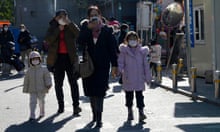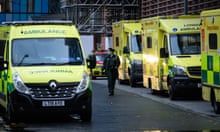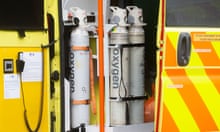Almost three times as many people are dying of flu in the UK this winter as last year, figures reveal.
After 35 more deaths last week, 120 people across the country have died of flu-related symptoms since early October, compared with 45 in the same period in 2016-17.
Separate figures, released on Thursday by the Royal College of GPs, showed that more than 30,000 people visited a GP last week as a result of influenza-like illness, an increase of more than 9,000 compared with the first week of January.
However, Public Health England (PHE) declared that while flu was rendering the largest number of people seriously unwell since the winter of 2010/11, it was still not an epidemic.
Last week saw 598 people admitted to hospital with flu, of whom 198 were so sick they had to be treated in an intensive care or high dependency unit. However, both numbers were lower than the previous week.
The first two weeks of the year have also seen huge rises across all four home nations in people getting flu and turning to their GP for help.
In England, 21 people per 100,000 of population did so in the last week of December. But that more than doubled to 53.1 in the week that ended last Sunday, 14 January, according to data collected by PHE.
PHE analysis of GP consultations also showed that in Wales, rates almost quadrupled over the same fortnight from 16.7 to 64.9 per 100,000 people. Scotland and Northern Ireland saw smaller but still major rises, from 44.9 to 114 and 22.7 to 65.2 per 100,000 of population respectively.
The surge sparked fresh pleas from doctors for the millions of people who have not had the winter flu jab, including those at particular risk from the virus, to get immunised urgently.
York is the local authority area of England with the highest proportion of people suffering with flu, according to the PHE data. Last week 109.3 people per 100,000 of population there visited a GP as a result of the infection. The areas with the next highest rates are Herefordshire (102.5), North Somerset (95.3), Cheshire West and Chester (87.8) and Northumberland (83.2).
“In terms of hospital admission, this is the most significant flu season since the winter of 2010/11 and the preceding pandemic year of 2009 although it is not an epidemic”, said Prof Paul Cosford, PHE’s medical director.
“We are currently seeing a mix of flu types, including the A(H3N2) strain that circulated last winter in the UK and then in Australia. The A(H3N2) strain particularly affects older, more vulnerable age groups.”
The flu figures emerged hours after new performance data for the NHS in England revealed that up to 100,000 patients this winter have had to wait in the back of an ambulance for at least 30 minutes because of A&E overcrowding.
In total 104,987 patients brought to hospitals in England have been stuck inside an ambulance, or in parts of hospitals near the A&E including corridors, for upwards of half an hour. Ambulance crews have reported having to wait several hours outside an A&E with a patient in their vehicle in some cases in recent weeks.
Saffron Cordery, director of policy and strategy at NHS Providers, which represents hospitals, said that despite “a very slight easing of pressures last week, NHS trusts are still working at or beyond full stretch, resulting – at times – in care for patients that falls short of what trusts and their staff want to provide. The worst of winter may be yet to come”.
Q&AWhy is the NHS winter crisis so bad in 2017-18?
Show
A combination of factors are at play. Hospitals have fewer beds than last year, so they are less able to deal with the recent, ongoing surge in illness. Last week, for example, the bed occupancy rate at 17 of England’s 153 acute hospital trusts was 98% or more, with the fullest – Walsall healthcare trust – 99.9% occupied.
NHS England admits that the service “has been under sustained pressure [recently because of] high levels of respiratory illness, bed occupancy levels giving limited capacity to deal with demand surges, early indications of increasing flu prevalence and some reports suggesting a rise in the severity of illness among patients arriving at A&Es”.
Many NHS bosses and senior doctors say that the pressure the NHS is under now is the heaviest it has ever been. “We are seeing conditions that people have not experienced in their working lives,” says Dr Taj Hassan, the president of the Royal College of Emergency Medicine.
The unprecedented nature of the measures that NHS bosses have told hospitals to take – including cancelling tens of thousands of operations and outpatient appointments until at least the end of January – underlines the seriousness of the situation facing NHS services, including ambulance crews and GP surgeries.
Meanwhile, 20 people died while waiting too long for ambulances in the east of England after the ambulance service there failed to seek outside help during the busy period over Christmas, a Labour MP has claimed, citing a whistleblower.
Clive Lewis, the MP for Norwich South, used a point of order in the Commons to highlight what he said was an “exceptionally serious issue” with the East of England ambulance service.
A cash injection of £1.8bn that was supposed to be spent stabilising the NHS’s finances has instead been used to cope with day-to-day pressures, a report by official auditors has found.
The NHS received the money from the Sustainability and Transformation Fund in 2016-17. It was meant to set up structures in order to survive on less money from 2017-18 onwards, the National Audit Office said on Friday.
The cash was instead spent by NHS England keeping the service afloat, auditors found, prompting questions about the government’s preparedness for future financial crises.
Additional reporting by Rajeev Syal









